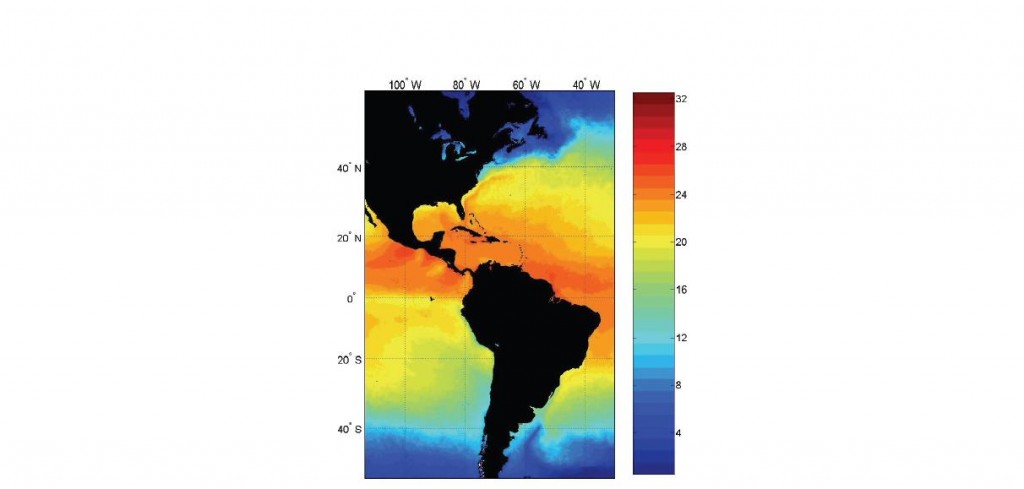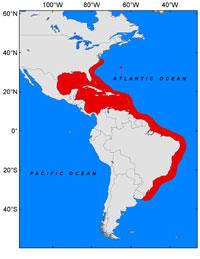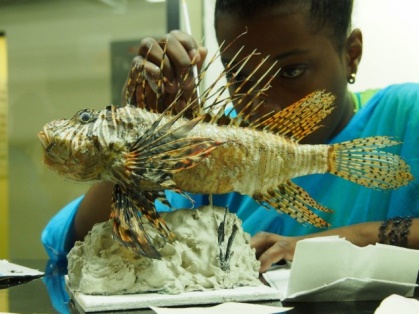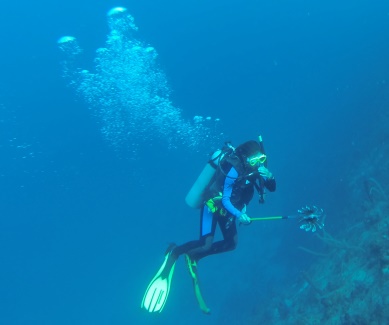They arrived by accident at the beginning of this century. They found a paradise in this region and decided to stay and multiply themselves.
At first glance they are lovely and are in almost every aquarium in the world, but today all of them represent a regional problem in the Caribbean port cities and these coastal communities in this region must contend them.
We are thinking of the infamous lionfish (Pterois miles and Pterois volitanns) (Pterois volitanns y Pterois miles).
Background
It is native to the Indo-Pacific and from the Red Sea.
In detail we can describe their original habitat, which covers a wide area, ranging from Western Australia and Malaysia in the west to French Polynesia and Pitcairn (United Kingdom) in eastern islands, and from southern parts of Japan and South Korea in the north to Lord Howe island (east of Australia) and the Kermadec islands (near new Zealand) in the south.
They have a personality that is characterized by slow and cryptic, aposematic coloration and have toxic spines as defense.
In their natural habitat is not listed as a threatened species or endangered.
The most credible theory about their arriving to America is that they were brought to the United States as one ornamental species for aquariums, and because of the effects of Hurricane Katrina in 2005, many specimens escaped in New Orleans. Gradually, they populated the Gulf of Mexico and for 2009 they were already up in Southern Colombia.
Dimensions of the problem
In the Great Caribbean area, lionfish represents a significant threat, both in ecological and economic terms.
In ecological terms, the problem begins with his great ability to adapt himself and how much he likes tropical waters. Observations on behavior show significant variations. For example, in their place of origin they are nocturnal predators, but in the Caribbean they eat all day. In comparison with specimens of the Indian Ocean, the Caribbean ones reach larger, heavier and earlier sexual pairing.
[/one_half] [one_half_last]
[/one_half_last]
Tropical region in American continent and registered invasive area with lionfish. (Source: Morris, J.A. Jr. and Akins. Feeding ecology of invasive lionfisch, 2009)It is a fact that the lionfish invasion has transformed the balance of ecosystems in the Caribbean reefs, and they have impacted others related, such as sea grass ecosystems and mangroves.
Socioeconomic threat is evident in the fishery activities, with a sharp decline and disappearance of species, but also this affects tourism, because they represent a danger to divers and swimmers.
Because the scope of colonization on record, it is unlikely one estimated eradication and, the best way to tackle the problem seems to be promoting the control of this species.
Control measures are highly variable, and so far have been successful in areas of strict management, such as marine parks in Mexico, the Florida Keys, the Cayman Islands, Bonaire and Puerto Rico.
Appropriate actions and resources are crucial to implementing battle plans against this plague, hence regions with lower conditions have been most affected, such as Cuba and Bahamas.
Portcity challenges
Facing this situation involves transforming adversity into advantage.
We saw very quickly that the lionfish has affected the value chains of two key activities in the economy of port cities: fishing and tourism. Also, the creation and implementation of management plans for the control of this species have important results because they help in containing the problem. This last point implies to take policies and decisions necessarily involving many public sector institutions and private companies and organizations.
What has not been said so far is that against the risk to the economic decline of the port cities of the Caribbean, creativity has been a key factor to reverse adversity.
Many fishermen have started training in taxidermy courses to make crafts with parts of lionfish: earrings for women and other decorative items; with what they have managed to recover his battered economy.
[one_third]
[/one_third] [one_third]
[/one_third]
[one_third_last]
[/one_third_last]
Three samples of fighting against lionfish in port cities: doing crafts, making a new gastronomy and varying diving. (Source: Fundación Puntacana/Javier Peñas, El País: El cocinero colombiano Jorge Rausch, https://blogs.elespectador.com)
The culinary creativity has not been left behind. Many restaurants, with the decline or disappearance of commonly consumed species (croaker, parrot fish and others) have enriched their menu to incorporate the lionfish as a special dish; prepared in many different ways, depending on the country or region. Today, cookbooks have been published online.
Moreover, some tourism activities such as diving, with the creation of security protocols, now organize group dives to observe and capture the lionfish.
There is an old saying that tells: “necessity is the mother of invention”. In this case, in the port cities, the inventiveness has been abundant and effective.
Head image: Lionfish image. (Source: https://www.crhoy.com)
Nuevos vecinos en las ciudades portuarias del Caribe: especies invasoras
Llegaron por accidente a inicios de este siglo XXI. Encontraron un paraíso en esta región y decidieron quedarse y multiplicarse.
A simple vista son encantadores y están en casi todos los acuarios del mundo, pero hoy representan un problema regional con el que las ciudades portuarias del Caribe y todas las comunidades costeras de esta región deben lidiar.
Hablamos del tristemente célebre pez león (Pterois volitanns y Pterois miles).
Sus antecedentes
Es originario de la región del Indo Pacífico y el Mar Rojo. Con detalle podemos describir su habitad original, que abarca un área muy extensa, que va desde Australia occidental y Malasia en el oeste, hasta la Polinesia Francesa y las islas Pitcaim (Reino Unido) en el este y, desde las zonas meridionales de Japón y Corea del Sur en el norte, hasta la isla de Lord Howe (al este de Australia) y las islas Kermadec (a la altura de nueva Zelanda) en el sur.
Poseen una personalidad que los caracteriza por ser lentos y crípticos, tienen una coloración aposemática y espinas toxicas que les sirven para defenderse.
En su hábitat natural no figura como una especie amenazada o en peligro de extinción.
La tesis más creíble acerca de su llegada al continente americano, señala que fueron traídos a los Estados Unidos por su valor ornamental, y a causa de los efectos del Huracán Katrina del 2005, muchos ejemplares escaparon de acuarios en Nueva Orleans. Poco a poco fueron poblando el Golfo de México y para el año 2009 ya se encontraban hasta en el sur de Colombia.
Las dimensiones del problema
En la región del Gran Caribe, el pez León representa una amenaza considerable, tanto en términos ecológicos como económicos.
En términos ecológicos el problema empieza por su gran capacidad de adaptación y lo mucho que le gustan las aguas tropicales. Observaciones sobre su comportamiento muestran variaciones importantes. Por ejemplo: en su lugar de origen son predadores nocturnos, pero en el Caribe comen todo el día, comparados con los ejemplares del Índico, los del Caribe alcanzan mayor tamaño, mayor peso e inician más temprano su reproducción.
Zona tropical del continente americano y el área de invasión registrada del pez León. (Fuente: Morris, J.A. Jr. and Akins. Feeding ecology of invasive lionfisch, 2009)
Está demostrado que la invasión del pez León ha transformado el equilibrio de los ecosistemas arrecifes del Caribe, y ha impactado otros ecosistemas conexos, tales como los pastos marinos y manglares.
La amenaza socioeconómica se hace evidente en la actividad pesquera, que ha notado una fuerte disminución y desaparición de otras especies, pero también afecta al turismo, porque representan un peligro para los buzos y bañistas.
Debido a los alcances de la colonización registrada hasta ahora, se estima improbable su erradicación, y la mejor manera de abordar el problema parece ser la promoción del control de esta especie. Las medidas de control son muy variables, y hasta ahora han dado buenos resultados en zonas de estricto manejo, como son los parques marinos de México, los Cayos de la Florida, las Islas Caimán, Bonaire y Puerto Rico.
Las acciones oportunas y recursos disponibles son determinantes en la ejecución de Planes de Manejo, de ahí que regiones con menores condiciones han resultado más afectadas, como Cuba y Bahamas.
Retos de la ciudad portuaria
Enfrentar esta situación implica transformar la adversidad en ventaja.
Vimos de manera muy rápida que el pez León ha afectado las cadenas de valor de dos actividades fundamentales de la economía de las ciudades portuarias: la pesca y el turismo. Y que la creación y ejecución de Planes de Manejo para el control de esta especie tienen resultados importantes porque ayudan a contener el problema. Este último punto implica voluntad política y, necesariamente, la participación de muchas instituciones del sector público y empresas y organizaciones privadas.
Lo que no se ha dicho hasta ahora, es que ante el riesgo del declive económico de las ciudades portuarias del Caribe, la creatividad ha sido un factor clave para revertir la adversidad.
Muchos pescadores han empezado a capacitarse en cursos de taxidermia para hacer artesanías con partes del pez león: aretes para dama y artículos decorativos y otros; con lo que han logrado recuperar su maltratada economía.
Formas en que las ciudades portuarias están enfrentando la invasión del pez Léon: cursos de artesanías, gastronomía y buceo. (Fuente: Fundación Puntacana/Javier Peñas, El País: El cocinero colombiano Jorge Rausch, https://blogs.elespectador.com)
La creatividad culinaria no se ha quedado atrás. Muchos restaurantes, ante la disminución o desaparición de especies de consumo común (corvina, pez loro y otros) han enriquecido su menú al incorporar el pez león como un plato especial; preparado de muy diversas maneras, dependiendo del país o región. Hoy, se han publicado recetarios por Internet.
Además, algunas actividades del turismo, como el buceo, con la creación de protocolos de seguridad, ahora organizan inmersiones grupales para observar y capturar el pez León.
Dice un viejo refrán que “la necesidad es la madre de la invención”, y en este caso, se ha visto que el ingenio en las ciudades portuarias es abundante y efectivo.
Head image: Imagen del pez Léon (Pterois volitanns y Pterois miles). (Fuente: https://www.crhoy.com)




